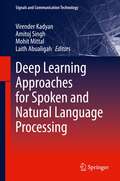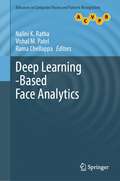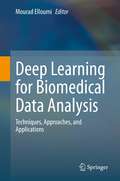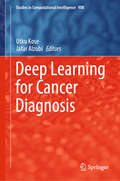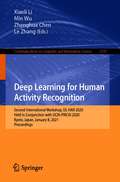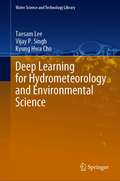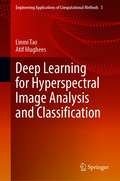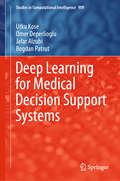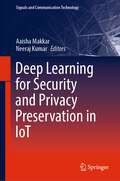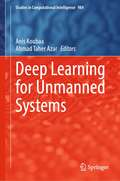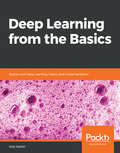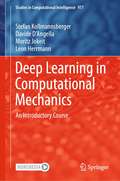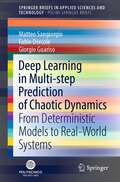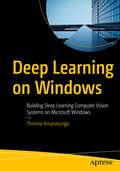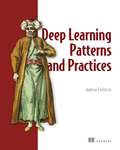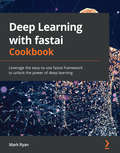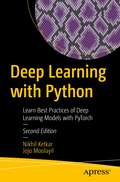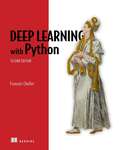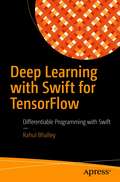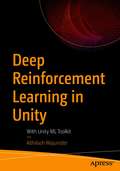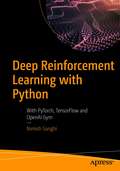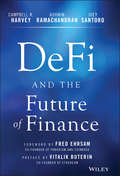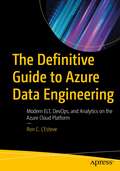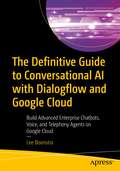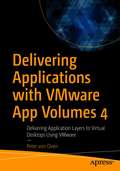- Table View
- List View
Deep Learning Approaches for Spoken and Natural Language Processing (Signals and Communication Technology)
by Virender Kadyan Amitoj Singh Mohit Mittal Laith AbualigahThis book provides insights into how deep learning techniques impact language and speech processing applications. The authors discuss the promise, limits and the new challenges in deep learning. The book covers the major differences between the various applications of deep learning and the classical machine learning techniques. The main objective of the book is to present a comprehensive survey of the major applications and research oriented articles based on deep learning techniques that are focused on natural language and speech signal processing. The book is relevant to academicians, research scholars, industrial experts, scientists and post graduate students working in the field of speech signal and natural language processing and would like to add deep learning to enhance capabilities of their work.Discusses current research challenges and future perspective about how deep learning techniques can be applied to improve NLP and speech processing applications;Presents and escalates the research trends and future direction of language and speech processing;Includes theoretical research, experimental results, and applications of deep learning.
Deep Learning-Based Face Analytics (Advances in Computer Vision and Pattern Recognition)
by Nalini K. Ratha Vishal M. Patel Rama ChellappaThis book provides an overview of different deep learning-based methods for face recognition and related problems. Specifically, the authors present methods based on autoencoders, restricted Boltzmann machines, and deep convolutional neural networks for face detection, localization, tracking, recognition, etc. The authors also discuss merits and drawbacks of available approaches and identifies promising avenues of research in this rapidly evolving field. Even though there have been a number of different approaches proposed in the literature for face recognition based on deep learning methods, there is not a single book available in the literature that gives a complete overview of these methods. The proposed book captures the state of the art in face recognition using various deep learning methods, and it covers a variety of different topics related to face recognition. This book is aimed at graduate students studying electrical engineering and/or computer science. Biometrics is a course that is widely offered at both undergraduate and graduate levels at many institutions around the world: This book can be used as a textbook for teaching topics related to face recognition. In addition, the work is beneficial to practitioners in industry who are working on biometrics-related problems. The prerequisites for optimal use are the basic knowledge of pattern recognition, machine learning, probability theory, and linear algebra.
Deep Learning for Biomedical Data Analysis: Techniques, Approaches, and Applications
by Mourad ElloumiThis book is the first overview on Deep Learning (DL) for biomedical data analysis. It surveys the most recent techniques and approaches in this field, with both a broad coverage and enough depth to be of practical use to working professionals. This book offers enough fundamental and technical information on these techniques, approaches and the related problems without overcrowding the reader's head. It presents the results of the latest investigations in the field of DL for biomedical data analysis. The techniques and approaches presented in this book deal with the most important and/or the newest topics encountered in this field. They combine fundamental theory of Artificial Intelligence (AI), Machine Learning (ML) and DL with practical applications in Biology and Medicine. Certainly, the list of topics covered in this book is not exhaustive but these topics will shed light on the implications of the presented techniques and approaches on other topics in biomedical data analysis. The book finds a balance between theoretical and practical coverage of a wide range of issues in the field of biomedical data analysis, thanks to DL. The few published books on DL for biomedical data analysis either focus on specific topics or lack technical depth. The chapters presented in this book were selected for quality and relevance. The book also presents experiments that provide qualitative and quantitative overviews in the field of biomedical data analysis. The reader will require some familiarity with AI, ML and DL and will learn about techniques and approaches that deal with the most important and/or the newest topics encountered in the field of DL for biomedical data analysis. He/she will discover both the fundamentals behind DL techniques and approaches, and their applications on biomedical data. This book can also serve as a reference book for graduate courses in Bioinformatics, AI, ML and DL. The book aims not only at professional researchers and practitioners but also graduate students, senior undergraduate students and young researchers. This book will certainly show the way to new techniques and approaches to make new discoveries.
Deep Learning for Cancer Diagnosis (Studies in Computational Intelligence #908)
by Utku Kose Jafar AlzubiThis book explores various applications of deep learning to the diagnosis of cancer,while also outlining the future face of deep learning-assisted cancer diagnostics. As is commonly known, artificial intelligence has paved the way for countless new solutions in the field of medicine. In this context, deep learning is a recent and remarkable sub-field, which can effectively cope with huge amounts of data and deliver more accurate results. As a vital research area, medical diagnosis is among those in which deep learning-oriented solutions are often employed.Accordingly, the objective of this book is to highlight recent advanced applications of deep learning for diagnosing different types of cancer. The target audience includes scientists, experts, MSc and PhD students, postdocs, and anyone interested in the subjects discussed. The book can be used as a reference work to support courses on artificial intelligence, medical and biomedicaleducation.
Deep Learning for Human Activity Recognition: Second International Workshop, DL-HAR 2020, Held in Conjunction with IJCAI-PRICAI 2020, Kyoto, Japan, January 8, 2021, Proceedings (Communications in Computer and Information Science #1370)
by Xiaoli Li Min Wu Zhenghua Chen Le ZhangThis book constitutes refereed proceedings of the Second International Workshop on Deep Learning for Human Activity Recognition, DL-HAR 2020, held in conjunction with IJCAI-PRICAI 2020, in Kyoto, Japan, in January 2021. Due to the COVID-19 pandemic the workshop was postponed to the year 2021 and held in a virtual format. The 10 presented papers were thorougly reviewed and included in the volume. They present recent research on applications of human activity recognition for various areas such as healthcare services, smart home applications, and more.
Deep Learning for Hydrometeorology and Environmental Science (Water Science and Technology Library #99)
by Taesam Lee Vijay P. Singh Kyung Hwa ChoThis book provides a step-by-step methodology and derivation of deep learning algorithms as Long Short-Term Memory (LSTM) and Convolution Neural Network (CNN), especially for estimating parameters, with back-propagation as well as examples with real datasets of hydrometeorology (e.g. streamflow and temperature) and environmental science (e.g. water quality). Deep learning is known as part of machine learning methodology based on the artificial neural network. Increasing data availability and computing power enhance applications of deep learning to hydrometeorological and environmental fields. However, books that specifically focus on applications to these fields are limited.Most of deep learning books demonstrate theoretical backgrounds and mathematics. However, examples with real data and step-by-step explanations to understand the algorithms in hydrometeorology and environmental science are very rare. This book focuses on the explanation of deep learning techniques and their applications to hydrometeorological and environmental studies with real hydrological and environmental data. This book covers the major deep learning algorithms as Long Short-Term Memory (LSTM) and Convolution Neural Network (CNN) as well as the conventional artificial neural network model.
Deep Learning for Hyperspectral Image Analysis and Classification (Engineering Applications of Computational Methods #5)
by Linmi Tao Atif MugheesThis book focuses on deep learning-based methods for hyperspectral image (HSI) analysis. Unsupervised spectral-spatial adaptive band-noise factor-based formulation is devised for HSI noise detection and band categorization. The method to characterize the bands along with the noise estimation of HSIs will benefit subsequent remote sensing techniques significantly. This book develops on two fronts: On the one hand, it is aimed at domain professionals who want to have an updated overview of how hyperspectral acquisition techniques can combine with deep learning architectures to solve specific tasks in different application fields. On the other hand, the authors want to target the machine learning and computer vision experts by giving them a picture of how deep learning technologies are applied to hyperspectral data from a multidisciplinary perspective. The presence of these two viewpoints and the inclusion of application fields of remote sensing by deep learning are the original contributions of this review, which also highlights some potentialities and critical issues related to the observed development trends.
Deep Learning for Medical Decision Support Systems (Studies in Computational Intelligence #909)
by Utku Kose Omer Deperlioglu Jafar Alzubi Bogdan PatrutThis book explores various applications of deep learning-oriented diagnosis leading to decision support, while also outlining the future face of medical decision support systems. Artificial intelligence has now become a ubiquitous aspect of modern life, and especially machine learning enjoysgreat popularity, since it offers techniques that are capable of learning from samples to solve newly encountered cases. Today, a recent form of machine learning, deep learning, is being widely used with large, complex quantities of data, because today’s problems require detailed analyses of more data. This is critical, especially in fields such as medicine. Accordingly, the objective of this book is to provide the essentials of and highlight recent applications of deep learning architectures for medical decision support systems. The target audience includes scientists, experts, MSc and PhD students, postdocs, and any readers interested in the subjectsdiscussed. The book canbe used as a reference work to support courses on artificial intelligence, machine/deep learning, medical and biomedicaleducation.
Deep Learning for Security and Privacy Preservation in IoT (Signals and Communication Technology)
by Aaisha Makkar Neeraj KumarThis book addresses the issues with privacy and security in Internet of things (IoT) networks which are susceptible to cyber-attacks and proposes deep learning-based approaches using artificial neural networks models to achieve a safer and more secured IoT environment. Due to the inadequacy of existing solutions to cover the entire IoT network security spectrum, the book utilizes artificial neural network models, which are used to classify, recognize, and model complex data including images, voice, and text, to enhance the level of security and privacy of IoT. This is applied to several IoT applications which include wireless sensor networks (WSN), meter reading transmission in smart grid, vehicular ad hoc networks (VANET), industrial IoT and connected networks. The book serves as a reference for researchers, academics, and network engineers who want to develop enhanced security and privacy features in the design of IoT systems.
Deep Learning for Unmanned Systems (Studies in Computational Intelligence #984)
by Anis Koubaa Ahmad Taher AzarThis book is used at the graduate or advanced undergraduate level and many others. Manned and unmanned ground, aerial and marine vehicles enable many promising and revolutionary civilian and military applications that will change our life in the near future. These applications include, but are not limited to, surveillance, search and rescue, environment monitoring, infrastructure monitoring, self-driving cars, contactless last-mile delivery vehicles, autonomous ships, precision agriculture and transmission line inspection to name just a few. These vehicles will benefit from advances of deep learning as a subfield of machine learning able to endow these vehicles with different capability such as perception, situation awareness, planning and intelligent control. Deep learning models also have the ability to generate actionable insights into the complex structures of large data sets. In recent years, deep learning research has received an increasing amount of attention from researchers in academia, government laboratories and industry. These research activities have borne some fruit in tackling some of the challenging problems of manned and unmanned ground, aerial and marine vehicles that are still open. Moreover, deep learning methods have been recently actively developed in other areas of machine learning, including reinforcement training and transfer/meta-learning, whereas standard, deep learning methods such as recent neural network (RNN) and coevolutionary neural networks (CNN). The book is primarily meant for researchers from academia and industry, who are working on in the research areas such as engineering, control engineering, robotics, mechatronics, biomedical engineering, mechanical engineering and computer science. The book chapters deal with the recent research problems in the areas of reinforcement learning-based control of UAVs and deep learning for unmanned aerial systems (UAS)The book chapters present various techniques of deep learning for robotic applications. The book chapters contain a good literature survey with a long list of references.The book chapters are well written with a good exposition of the research problem, methodology, block diagrams and mathematical techniques.The book chapters are lucidly illustrated with numerical examples and simulations.The book chapters discuss details of applications and future research areas.
Deep Learning from the Basics: Python and Deep Learning: Theory and Implementation
by Koki SaitohDiscover ways to implement various deep learning algorithms by leveraging Python and other technologiesKey FeaturesLearn deep learning models through several activitiesBegin with simple machine learning problems, and finish by building a complex system of your ownTeach your machines to see by mastering the technologies required for image recognitionBook DescriptionDeep learning is rapidly becoming the most preferred way of solving data problems. This is thanks, in part, to its huge variety of mathematical algorithms and their ability to find patterns that are otherwise invisible to us. Deep Learning from the Basics begins with a fast-paced introduction to deep learning with Python, its definition, characteristics, and applications. You'll learn how to use the Python interpreter and the script files in your applications, and utilize NumPy and Matplotlib in your deep learning models. As you progress through the book, you'll discover backpropagation—an efficient way to calculate the gradients of weight parameters—and study multilayer perceptrons and their limitations, before, finally, implementing a three-layer neural network and calculating multidimensional arrays. By the end of the book, you'll have the knowledge to apply the relevant technologies in deep learning.What you will learnUse Python with minimum external sources to implement deep learning programsStudy the various deep learning and neural network theoriesLearn how to determine learning coefficients and the initial values of weightsImplement trends such as Batch Normalization, Dropout, and AdamExplore applications like automatic driving, image generation, and reinforcement learningWho this book is forDeep Learning from the Basics is designed for data scientists, data analysts, and developers who want to use deep learning techniques to develop efficient solutions. This book is ideal for those who want a deeper understanding as well as an overview of the technologies. Some working knowledge of Python is a must. Knowledge of NumPy and pandas will be beneficial, but not essential.
Deep Learning in Computational Mechanics: An Introductory Course (Studies in Computational Intelligence #977)
by Stefan Kollmannsberger Moritz Jokeit Leon Herrmann Davide D'AngellaThis book provides a first course on deep learning in computational mechanics. The book starts with a short introduction to machine learning’s fundamental concepts before neural networks are explained thoroughly. It then provides an overview of current topics in physics and engineering, setting the stage for the book’s main topics: physics-informed neural networks and the deep energy method.The idea of the book is to provide the basic concepts in a mathematically sound manner and yet to stay as simple as possible. To achieve this goal, mostly one-dimensional examples are investigated, such as approximating functions by neural networks or the simulation of the temperature’s evolution in a one-dimensional bar.Each chapter contains examples and exercises which are either solved analytically or in PyTorch, an open-source machine learning framework for python.
Deep Learning in Multi-step Prediction of Chaotic Dynamics: From Deterministic Models to Real-World Systems (SpringerBriefs in Applied Sciences and Technology)
by Giorgio Guariso Fabio Dercole Matteo SangiorgioThe book represents the first attempt to systematically deal with the use of deep neural networks to forecast chaotic time series. Differently from most of the current literature, it implements a multi-step approach, i.e., the forecast of an entire interval of future values. This is relevant for many applications, such as model predictive control, that requires predicting the values for the whole receding horizon. Going progressively from deterministic models with different degrees of complexity and chaoticity to noisy systems and then to real-world cases, the book compares the performances of various neural network architectures (feed-forward and recurrent). It also introduces an innovative and powerful approach for training recurrent structures specific for sequence-to-sequence tasks. The book also presents one of the first attempts in the context of environmental time series forecasting of applying transfer-learning techniques such as domain adaptation.
Deep Learning on Windows: Building Deep Learning Computer Vision Systems on Microsoft Windows
by Thimira AmaratungaBuild deep learning and computer vision systems using Python, TensorFlow, Keras, OpenCV, and more, right within the familiar environment of Microsoft Windows. The book starts with an introduction to tools for deep learning and computer vision tasks followed by instructions to install, configure, and troubleshoot them. Here, you will learn how Python can help you build deep learning models on Windows. Moving forward, you will build a deep learning model and understand the internal-workings of a convolutional neural network on Windows. Further, you will go through different ways to visualize the internal-workings of deep learning models along with an understanding of transfer learning where you will learn how to build model architecture and use data augmentations. Next, you will manage and train deep learning models on Windows before deploying your application as a web application. You’ll also do some simple image processing and work with computer vision options that will help you build various applications with deep learning. Finally, you will use generative adversarial networks along with reinforcement learning. After reading Deep Learning on Windows, you will be able to design deep learning models and web applications on the Windows operating system. What You Will LearnUnderstand the basics of Deep Learning and its historyGet Deep Learning tools working on Microsoft WindowsUnderstand the internal-workings of Deep Learning models by using model visualization techniques, such as the built-in plot_model function of Keras and third-party visualization toolsUnderstand Transfer Learning and how to utilize it to tackle small datasetsBuild robust training scripts to handle long-running training jobsConvert your Deep Learning model into a web applicationGenerate handwritten digits and human faces with DCGAN (Deep Convolutional Generative Adversarial Network)Understand the basics of Reinforcement Learning Who This Book Is For AI developers and enthusiasts wanting to work on the Windows platform.
Deep Learning Patterns and Practices
by Andrew FerlitschDiscover best practices, reproducible architectures, and design patterns to help guide deep learning models from the lab into production.In Deep Learning Patterns and Practices you will learn: Internal functioning of modern convolutional neural networks Procedural reuse design pattern for CNN architectures Models for mobile and IoT devices Assembling large-scale model deployments Optimizing hyperparameter tuning Migrating a model to a production environment The big challenge of deep learning lies in taking cutting-edge technologies from R&D labs through to production. Deep Learning Patterns and Practices is here to help. This unique guide lays out the latest deep learning insights from author Andrew Ferlitsch&’s work with Google Cloud AI. In it, you'll find deep learning models presented in a unique new way: as extendable design patterns you can easily plug-and-play into your software projects. Each valuable technique is presented in a way that's easy to understand and filled with accessible diagrams and code samples. Purchase of the print book includes a free eBook in PDF, Kindle, and ePub formats from Manning Publications. About the technology Discover best practices, design patterns, and reproducible architectures that will guide your deep learning projects from the lab into production. This awesome book collects and illuminates the most relevant insights from a decade of real world deep learning experience. You&’ll build your skills and confidence with each interesting example. About the book Deep Learning Patterns and Practices is a deep dive into building successful deep learning applications. You&’ll save hours of trial-and-error by applying proven patterns and practices to your own projects. Tested code samples, real-world examples, and a brilliant narrative style make even complex concepts simple and engaging. Along the way, you&’ll get tips for deploying, testing, and maintaining your projects. What's inside Modern convolutional neural networks Design pattern for CNN architectures Models for mobile and IoT devices Large-scale model deployments Examples for computer vision About the reader For machine learning engineers familiar with Python and deep learning. About the author Andrew Ferlitsch is an expert on computer vision, deep learning, and operationalizing ML in production at Google Cloud AI Developer Relations. Table of Contents PART 1 DEEP LEARNING FUNDAMENTALS 1 Designing modern machine learning 2 Deep neural networks 3 Convolutional and residual neural networks 4 Training fundamentals PART 2 BASIC DESIGN PATTERN 5 Procedural design pattern 6 Wide convolutional neural networks 7 Alternative connectivity patterns 8 Mobile convolutional neural networks 9 Autoencoders PART 3 WORKING WITH PIPELINES 10 Hyperparameter tuning 11 Transfer learning 12 Data distributions 13 Data pipeline 14 Training and deployment pipeline
Deep Learning with fastai Cookbook: Leverage the easy-to-use fastai framework to unlock the power of deep learning
by Mark RyanHarness the power of the easy-to-use, high-performance fastai framework to rapidly create complete deep learning solutions with few lines of codeKey FeaturesDiscover how to apply state-of-the-art deep learning techniques to real-world problemsBuild and train neural networks using the power and flexibility of the fastai frameworkUse deep learning to tackle problems such as image classification and text classificationBook Descriptionfastai is an easy-to-use deep learning framework built on top of PyTorch that lets you rapidly create complete deep learning solutions with as few as 10 lines of code. Both predominant low-level deep learning frameworks, TensorFlow and PyTorch, require a lot of code, even for straightforward applications. In contrast, fastai handles the messy details for you and lets you focus on applying deep learning to actually solve problems.The book begins by summarizing the value of fastai and showing you how to create a simple 'hello world' deep learning application with fastai. You'll then learn how to use fastai for all four application areas that the framework explicitly supports: tabular data, text data (NLP), recommender systems, and vision data. As you advance, you'll work through a series of practical examples that illustrate how to create real-world applications of each type. Next, you'll learn how to deploy fastai models, including creating a simple web application that predicts what object is depicted in an image. The book wraps up with an overview of the advanced features of fastai.By the end of this fastai book, you'll be able to create your own deep learning applications using fastai. You'll also have learned how to use fastai to prepare raw datasets, explore datasets, train deep learning models, and deploy trained models.What you will learnPrepare real-world raw datasets to train fastai deep learning modelsTrain fastai deep learning models using text and tabular dataCreate recommender systems with fastaiFind out how to assess whether fastai is a good fit for a given problemDeploy fastai deep learning models in web applicationsTrain fastai deep learning models for image classificationWho this book is forThis book is for data scientists, machine learning developers, and deep learning enthusiasts looking to explore the fastai framework using a recipe-based approach. Working knowledge of the Python programming language and machine learning basics is strongly recommended to get the most out of this deep learning book.
Deep Learning with Python: Learn Best Practices of Deep Learning Models with PyTorch
by Nikhil Ketkar Jojo MoolayilMaster the practical aspects of implementing deep learning solutions with PyTorch, using a hands-on approach to understanding both theory and practice. This updated edition will prepare you for applying deep learning to real world problems with a sound theoretical foundation and practical know-how with PyTorch, a platform developed by Facebook’s Artificial Intelligence Research Group.You'll start with a perspective on how and why deep learning with PyTorch has emerged as an path-breaking framework with a set of tools and techniques to solve real-world problems. Next, the book will ground you with the mathematical fundamentals of linear algebra, vector calculus, probability and optimization. Having established this foundation, you'll move on to key components and functionality of PyTorch including layers, loss functions and optimization algorithms. You'll also gain an understanding of Graphical Processing Unit (GPU) based computation, which is essential for training deep learning models. All the key architectures in deep learning are covered, including feedforward networks, convolution neural networks, recurrent neural networks, long short-term memory networks, autoencoders and generative adversarial networks. Backed by a number of tricks of the trade for training and optimizing deep learning models, this edition of Deep Learning with Python explains the best practices in taking these models to production with PyTorch.What You'll LearnReview machine learning fundamentals such as overfitting, underfitting, and regularization.Understand deep learning fundamentals such as feed-forward networks, convolution neural networks, recurrent neural networks, automatic differentiation, and stochastic gradient descent.Apply in-depth linear algebra with PyTorchExplore PyTorch fundamentals and its building blocksWork with tuning and optimizing models Who This Book Is ForBeginners with a working knowledge of Python who want to understand Deep Learning in a practical, hands-on manner.
Deep Learning with Python, Second Edition
by François CholletUnlock the groundbreaking advances of deep learning with this extensively revised new edition of the bestselling original. Learn directly from the creator of Keras and master practical Python deep learning techniques that are easy to apply in the real world.In Deep Learning with Python, Second Edition you will learn: Deep learning from first principles Image classification and image segmentation Timeseries forecasting Text classification and machine translation Text generation, neural style transfer, and image generation Deep Learning with Python has taught thousands of readers how to put the full capabilities of deep learning into action. This extensively revised second edition introduces deep learning using Python and Keras, and is loaded with insights for both novice and experienced ML practitioners. You&’ll learn practical techniques that are easy to apply in the real world, and important theory for perfecting neural networks. Purchase of the print book includes a free eBook in PDF, Kindle, and ePub formats from Manning Publications. About the technology Recent innovations in deep learning unlock exciting new software capabilities like automated language translation, image recognition, and more. Deep learning is quickly becoming essential knowledge for every software developer, and modern tools like Keras and TensorFlow put it within your reach—even if you have no background in mathematics or data science. This book shows you how to get started. About the book Deep Learning with Python, Second Edition introduces the field of deep learning using Python and the powerful Keras library. In this revised and expanded new edition, Keras creator François Chollet offers insights for both novice and experienced machine learning practitioners. As you move through this book, you&’ll build your understanding through intuitive explanations, crisp illustrations, and clear examples. You&’ll quickly pick up the skills you need to start developing deep-learning applications. What's inside Deep learning from first principles Image classification and image segmentation Time series forecasting Text classification and machine translation Text generation, neural style transfer, and image generation About the reader For readers with intermediate Python skills. No previous experience with Keras, TensorFlow, or machine learning is required. About the author François Chollet is a software engineer at Google and creator of the Keras deep-learning library. Table of Contents 1 What is deep learning? 2 The mathematical building blocks of neural networks 3 Introduction to Keras and TensorFlow 4 Getting started with neural networks: Classification and regression 5 Fundamentals of machine learning 6 The universal workflow of machine learning 7 Working with Keras: A deep dive 8 Introduction to deep learning for computer vision 9 Advanced deep learning for computer vision 10 Deep learning for timeseries 11 Deep learning for text 12 Generative deep learning 13 Best practices for the real world 14 Conclusions
Deep Learning with Swift for TensorFlow: Differentiable Programming with Swift
by Rahul BhalleyDiscover more insight about deep learning algorithms with Swift for TensorFlow. The Swift language was designed by Apple for optimized performance and development whereas TensorFlow library was designed by Google for advanced machine learning research. Swift for TensorFlow is a combination of both with support for modern hardware accelerators and more. This book covers the deep learning concepts from fundamentals to advanced research. It also introduces the Swift language for beginners in programming. This book is well suited for newcomers and experts in programming and deep learning alike. After reading this book you should be able to program various state-of-the-art deep learning algorithms yourself. The book covers foundational concepts of machine learning. It also introduces the mathematics required to understand deep learning. Swift language is introduced such that it allows beginners and researchers to understand programming and easily transit to Swift for TensorFlow, respectively. You will understand the nuts and bolts of building and training neural networks, and build advanced algorithms. What You’ll Learn • Understand deep learning concepts • Program various deep learning algorithms • Run the algorithms in cloud Who This Book Is For • Newcomers to programming and/or deep learning, and experienced developers. • Experienced deep learning practitioners and researchers who desire to work in user space instead of library space with a same programming language without compromising the speed
Deep Reinforcement Learning in Unity: With Unity ML Toolkit
by Abhilash MajumderGain an in-depth overview of reinforcement learning for autonomous agents in game development with Unity.This book starts with an introduction to state-based reinforcement learning algorithms involving Markov models, Bellman equations, and writing custom C# code with the aim of contrasting value and policy-based functions in reinforcement learning. Then, you will move on to path finding and navigation meshes in Unity, setting up the ML Agents Toolkit (including how to install and set up ML agents from the GitHub repository), and installing fundamental machine learning libraries and frameworks (such as Tensorflow). You will learn about: deep learning and work through an introduction to Tensorflow for writing neural networks (including perceptron, convolution, and LSTM networks), Q learning with Unity ML agents, and porting trained neural network models in Unity through the Python-C# API. You will also explore the OpenAI Gym Environment used throughout the book.Deep Reinforcement Learning in Unity provides a walk-through of the core fundamentals of deep reinforcement learning algorithms, especially variants of the value estimation, advantage, and policy gradient algorithms (including the differences between on and off policy algorithms in reinforcement learning). These core algorithms include actor critic, proximal policy, and deep deterministic policy gradients and its variants. And you will be able to write custom neural networks using the Tensorflow and Keras frameworks. Deep learning in games makes the agents learn how they can perform better and collect their rewards in adverse environments without user interference. The book provides a thorough overview of integrating ML Agents with Unity for deep reinforcement learning.What You Will Learn Understand how deep reinforcement learning works in gamesGrasp the fundamentals of deep reinforcement learning Integrate these fundamentals with the Unity ML Toolkit SDKGain insights into practical neural networks for training Agent Brain in the context of Unity ML AgentsCreate different models and perform hyper-parameter tuningUnderstand the Brain-Academy architecture in Unity ML AgentsUnderstand the Python-C# API interface during real-time training of neural networksGrasp the fundamentals of generic neural networks and their variants using TensorflowCreate simulations and visualize agents playing games in Unity Who This Book Is ForReaders with preliminary programming and game development experience in Unity, and those with experience in Python and a general idea of machine learning
Deep Reinforcement Learning with Python: With PyTorch, TensorFlow and OpenAI Gym
by Nimish SanghiDeep reinforcement learning is a fast-growing discipline that is making a significant impact in fields of autonomous vehicles, robotics, healthcare, finance, and many more. This book covers deep reinforcement learning using deep-q learning and policy gradient models with coding exercise.You'll begin by reviewing the Markov decision processes, Bellman equations, and dynamic programming that form the core concepts and foundation of deep reinforcement learning. Next, you'll study model-free learning followed by function approximation using neural networks and deep learning. This is followed by various deep reinforcement learning algorithms such as deep q-networks, various flavors of actor-critic methods, and other policy-based methods. You'll also look at exploration vs exploitation dilemma, a key consideration in reinforcement learning algorithms, along with Monte Carlo tree search (MCTS), which played a key role in the success of AlphaGo. The final chapters conclude with deep reinforcement learning implementation using popular deep learning frameworks such as TensorFlow and PyTorch. In the end, you'll understand deep reinforcement learning along with deep q networks and policy gradient models implementation with TensorFlow, PyTorch, and Open AI Gym.What You'll LearnExamine deep reinforcement learning Implement deep learning algorithms using OpenAI’s Gym environmentCode your own game playing agents for Atari using actor-critic algorithmsApply best practices for model building and algorithm training Who This Book Is ForMachine learning developers and architects who want to stay ahead of the curve in the field of AI and deep learning.
DeFi and the Future of Finance
by Campbell R. Harvey Ashwin Ramachandran Joey SantoroDuring the Global Financial Crisis in 2008, our financial infrastructure failed. Governments bailed out the very institutions that let the economy down. This episode spurred a serious rethink of our financial system. Does it make any sense that it takes two days to settle a stock transaction? Why do retailers, operating on razor thin margins, have to pay 3% for every customer credit card swipe? Why does it take two days to transfer money from a bank account to a brokerage—or any other company? Why are savings rates miniscule or negative? Why is it so difficult for entrepreneurs to get financing at traditional banks? In DeFi and the Future of Finance, Campbell R. Harvey, Ashwin Ramachandran and Joey Santoro, introduce the new world of Decentralized Finance. The book argues that the current financial landscape is ripe for disruption and we are seeing, in real time, the reinvention of finance. The authors provide the reader with a clear assessment of the problems with the current financial system and how DeFi solves many of these problems. The essence of DeFi is that we interact with peers—there is no brick and mortar and all of the associated costs. Savings and lending are reinvented. Trading takes place with algorithms far removed from traditional brokerages. The book conducts a deep dive on some of the most innovative protocols such as Uniswap and Compound. Many of the companies featured in the book you might not have heard of—however, you will in the future. As with any new technology, there are a myriad of risks and the authors carefully catalogue these risks and assess which ones can be successfully mitigated. Ideally suited for people working in any part of the finance industry as well as financial policy makers, DeFi and the Future of Finance gives readers a vision of the future. The world of finance will fundamentally be changed over the coming decade. The book enables you to become part of the disruption – not the target of the disruption.
The Definitive Guide to Azure Data Engineering: Modern ELT, DevOps, and Analytics on the Azure Cloud Platform
by Ron C. L'EsteveBuild efficient and scalable batch and real-time data ingestion pipelines, DevOps continuous integration and deployment pipelines, and advanced analytics solutions on the Azure Data Platform. This book teaches you to design and implement robust data engineering solutions using Data Factory, Databricks, Synapse Analytics, Snowflake, Azure SQL database, Stream Analytics, Cosmos database, and Data Lake Storage Gen2. You will learn how to engineer your use of these Azure Data Platform components for optimal performance and scalability. You will also learn to design self-service capabilities to maintain and drive the pipelines and your workloads. The approach in this book is to guide you through a hands-on, scenario-based learning process that will empower you to promote digital innovation best practices while you work through your organization’s projects, challenges, and needs. The clear examples enable you to use this book as a reference and guide for building data engineering solutions in Azure. After reading this book, you will have a far stronger skill set and confidence level in getting hands on with the Azure Data Platform.What You Will LearnBuild dynamic, parameterized ELT data ingestion orchestration pipelines in Azure Data FactoryCreate data ingestion pipelines that integrate control tables for self-service ELTImplement a reusable logging framework that can be applied to multiple pipelinesIntegrate Azure Data Factory pipelines with a variety of Azure data sources and toolsTransform data with Mapping Data Flows in Azure Data FactoryApply Azure DevOps continuous integration and deployment practices to your Azure Data Factory pipelines and development SQL databasesDesign and implement real-time streaming and advanced analytics solutions using Databricks, Stream Analytics, and Synapse AnalyticsGet started with a variety of Azure data services through hands-on examplesWho This Book Is ForData engineers and data architects who are interested in learning architectural and engineering best practices around ELT and ETL on the Azure Data Platform, those who are creating complex Azure data engineering projects and are searching for patterns of success, and aspiring cloud and data professionals involved in data engineering, data governance, continuous integration and deployment of DevOps practices, and advanced analytics who want a full understanding of the many different tools and technologies that Azure Data Platform provides
The Definitive Guide to Conversational AI with Dialogflow and Google Cloud
by Lee BoonstraBuild enterprise chatbots for web, social media, voice assistants, IoT, and telephony contact centers with Google's Dialogflow conversational AI technology. This book will explain how to get started with conversational AI using Google and how enterprise users can use Dialogflow as part of Google Cloud. It will cover the core concepts such as Dialogflow essentials, deploying chatbots on web and social media channels, and building voice agents including advanced tips and tricks such as intents, entities, and working with context. <P><P> The Definitive Guide to Conversational AI with Dialogflow and Google Cloud also explains how to build multilingual chatbots, orchestrate sub chatbots into a bigger conversational platform, use virtual agent analytics with popular tools, such as BigQuery or Chatbase, and build voice bots. It concludes with coverage of more advanced use cases, such as building fulfillment functionality, building your own integrations, securing your chatbots, and building your own voice platform with the Dialogflow SDK and other Google Cloud machine learning APIs. After reading this book, you will understand how to build cross-channel enterprise bots with popular Google tools such as Dialogflow, Google Cloud AI, Cloud Run, Cloud Functions, and Chatbase.
Delivering Applications with VMware App Volumes 4: Delivering Application Layers to Virtual Desktops Using VMware
by Peter von OvenAcquire the skills to build an App Volumes environment for a proof of concept, a pilot, or a live production environment. Delivering Applications with VMware App Volumes 4 starts with an in-depth overview of where the solution fits within the market and its key features, introducing you to application layering and VMware App Volumes. Next, it explains how to install the software and use its management consoles to configure App Volumes. You will understand how to build and configure application layers for delivery and will learn to build and configure writeable volumes for user data and user-installed applications. In the advanced management section, you will learn to customize package templates and integrate App Volumes with JMP. Along the way you will understand how to deliver published apps in MS RemoteApp using layered apps for scalability. In the next phase of the book you will install and configure App Volumes for different use cases: VMware Horizon View, VMware ThinApp, Microsoft RDSH, and Citrix Virtual Apps and Desktops. Throughout the chapters, you will be given hints and tips, along with best practices, all seen from the eyes of somebody who works with this technology day in, day out, and in many different types of environments and scenarios. What You Will Learn Understand the App Volumes architecture Master the concept of application layeringWork with App Volumes, application packages, and Writable Volumes Who This Book Is For VMware professionals, system integrators, IT professionals, and consultants.
